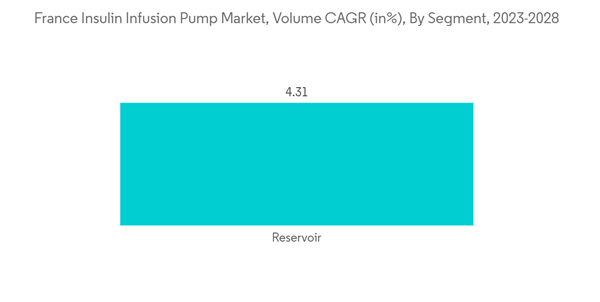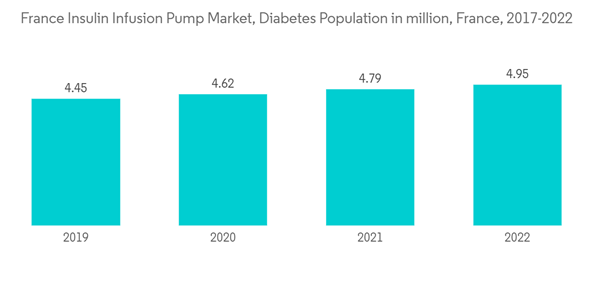The France Insulin Infusion Pump Market size is estimated at USD 130.74 million in 2024, and is expected to reach USD 159.56 million by 2029, growing at a CAGR of 4.06% during the forecast period (2024-2029).
Diabetes was one of the most prominent risk factors for a severe COVID-19 course. This risk was assumed to be influenced by several diabetes-related variables. Factors include age, a proinflammatory and hypercoagulable condition, hyperglycemia, hypertension, cardiovascular disease, chronic renal disease, and obesity. Diabetes was recognized as a risk factor for poor outcomes early in the COVID-19 pandemic. As a result, managing or delaying the onset of type-2 diabetes was more important than ever. During the COVID-19 pandemic, diabetic medicines were evaluated as potential therapies for people with diabetes infected with SARS-CoV-2.
Diabetes drugs are medications used to control and stabilize blood glucose levels in people with diabetes. Diabetes drugs are frequently used to treat the condition. Diabetes drugs are divided into various groups. Each type of medication has a distinct mechanism of action for decreasing blood sugar. A drug may work by stimulating the pancreas to make and release more insulin, decreasing the liver's ability to generate and release sugar, suppressing the activity of enzymes in the intestines that break down carbohydrates, and various other ways. It also increases insulin sensitivity in cells, lowering the kidneys' ability to absorb sugar and increasing the amount of sugar excreted in the urine.
Diabetes has the highest prevalence of any chronic disease covered by France's statutory health insurance (SHI), and the number of insured patients has more than doubled in the previous decade. Diabetes is growing increasingly widespread among individuals of all ages in France, which can be attributed to increased obesity, poor diets, and sedentary lives. Thus, growing diabetes and obesity prevalence, higher diabetic care awareness, increased healthcare spending, and technological advancements drive the French pump market.
It works straightforwardly, with instructions at the hospital and frequent follow-ups with the diabetologist and pump seller. Specialist diabetic nurses in France must complete a particular academic degree and work in preventing and caring for type-1 diabetes (T1D), type-2 diabetes (T2D), and gestational diabetes. They are not permitted to give diabetic medications, but they can give instructions on how to use an Insulin pump. The sale of the insulin pump is, therefore, a sector of the diabetes treatment market and, more specifically, insulin therapy; in this regard, the insulin pump is an intriguing alternative to multi-injection insulin treatment with pens and enables superior glycemic control. However, in France, more than anywhere else, the insulin pump industry requires promotion and more diabetes educators than regular doctors to function.
Owing to the above factors, the market will likely continue to grow.
In France, insulin and most related supplies and technology are free to all people with diabetes (PwD). Except for diabetic foot, screening for diabetes-related complications is accessible according to national recommendations. Only individuals with pre-existing foot issues are eligible for screening. A regional five-year health plan complements national health policy standards. Policies promoting healthy lifestyles are also in place. However, policies governing healthy eating habits must be more ambitious and effective. The country has a functioning diabetes registry for patients with T1D and electronic health data. However, they are not extensively used. E-health is mostly used for video consultations and electronic prescriptions.
Because of the disease's increasing incidence, prevalence, and progressive nature, new medications have been developed to give more therapy choices for diabetic patients. The introduction of several new medicines, increased international research partnerships in technological improvement, and increased public awareness of diabetes are some of the key prospects for participants in the French insulin pump market.
As a consequence of the factors above, the investigated market is predicted to grow during the investigation.
This product will be delivered within 2 business days.
Diabetes was one of the most prominent risk factors for a severe COVID-19 course. This risk was assumed to be influenced by several diabetes-related variables. Factors include age, a proinflammatory and hypercoagulable condition, hyperglycemia, hypertension, cardiovascular disease, chronic renal disease, and obesity. Diabetes was recognized as a risk factor for poor outcomes early in the COVID-19 pandemic. As a result, managing or delaying the onset of type-2 diabetes was more important than ever. During the COVID-19 pandemic, diabetic medicines were evaluated as potential therapies for people with diabetes infected with SARS-CoV-2.
Diabetes drugs are medications used to control and stabilize blood glucose levels in people with diabetes. Diabetes drugs are frequently used to treat the condition. Diabetes drugs are divided into various groups. Each type of medication has a distinct mechanism of action for decreasing blood sugar. A drug may work by stimulating the pancreas to make and release more insulin, decreasing the liver's ability to generate and release sugar, suppressing the activity of enzymes in the intestines that break down carbohydrates, and various other ways. It also increases insulin sensitivity in cells, lowering the kidneys' ability to absorb sugar and increasing the amount of sugar excreted in the urine.
Diabetes has the highest prevalence of any chronic disease covered by France's statutory health insurance (SHI), and the number of insured patients has more than doubled in the previous decade. Diabetes is growing increasingly widespread among individuals of all ages in France, which can be attributed to increased obesity, poor diets, and sedentary lives. Thus, growing diabetes and obesity prevalence, higher diabetic care awareness, increased healthcare spending, and technological advancements drive the French pump market.
France Insulin Infusion Pump Market Trends
Insulin Pump is Expected to Witness Growth Over the Forecast Period
An insulin pump is a device that continuously or, as needed, distributes insulin. The pump is modeled after the human pancreas. The insulin infusion pump can be used instead of a daily injection regimen or an insulin pen. Insulin pump treatment is a popular technique of insulin delivery for people with type 1 diabetes (T1DM). Pumps are a well-known and tried-and-true therapeutic option for T1DM patients of all ages, providing near-physiological insulin administration when the pancreas fails to generate insulin. Remote-controlled insulin pumps allow parents to suspend or bolus insulin from a safe distance while their child is playing or eating.It works straightforwardly, with instructions at the hospital and frequent follow-ups with the diabetologist and pump seller. Specialist diabetic nurses in France must complete a particular academic degree and work in preventing and caring for type-1 diabetes (T1D), type-2 diabetes (T2D), and gestational diabetes. They are not permitted to give diabetic medications, but they can give instructions on how to use an Insulin pump. The sale of the insulin pump is, therefore, a sector of the diabetes treatment market and, more specifically, insulin therapy; in this regard, the insulin pump is an intriguing alternative to multi-injection insulin treatment with pens and enables superior glycemic control. However, in France, more than anywhere else, the insulin pump industry requires promotion and more diabetes educators than regular doctors to function.
Owing to the above factors, the market will likely continue to grow.
Rising diabetes prevalence in the country is anticipated to boost the market studied
According to an EU Commission poll, the number of people with chronic diabetes is highest in France, with one in every ten suffering from the disease. Diabetes is common in France, although the guidelines' aim of 80% compliance with recommended healthcare visits is not always fulfilled. To reduce the burden of diabetes, innovative strategies focusing on patient and physician education and information are required to encourage proactive therapy modification and diminish therapeutic inertia.In France, insulin and most related supplies and technology are free to all people with diabetes (PwD). Except for diabetic foot, screening for diabetes-related complications is accessible according to national recommendations. Only individuals with pre-existing foot issues are eligible for screening. A regional five-year health plan complements national health policy standards. Policies promoting healthy lifestyles are also in place. However, policies governing healthy eating habits must be more ambitious and effective. The country has a functioning diabetes registry for patients with T1D and electronic health data. However, they are not extensively used. E-health is mostly used for video consultations and electronic prescriptions.
Because of the disease's increasing incidence, prevalence, and progressive nature, new medications have been developed to give more therapy choices for diabetic patients. The introduction of several new medicines, increased international research partnerships in technological improvement, and increased public awareness of diabetes are some of the key prospects for participants in the French insulin pump market.
As a consequence of the factors above, the investigated market is predicted to grow during the investigation.
France Insulin Infusion Pump Industry Overview
Due to the existence of only a few big businesses operating internationally and locally, the insulin infusion pump industry is concentrated. The competitive landscape includes examining a few well-known worldwide and local organizations, such as Medtronic PLC, Insulet Corporation, Ypsomed, Ascensia Diabetes Care, and Tandem Diabetes Care.Additional Benefits:
- The market estimate (ME) sheet in Excel format
- 3 months of analyst support
This product will be delivered within 2 business days.
Table of Contents
1 INTRODUCTION
4 MARKET DYNAMICS
5 MARKET SEGMENTATION
6 MARKET INDICATORS
7 COMPETITIVE LANDSCAPE
Methodology

LOADING...










